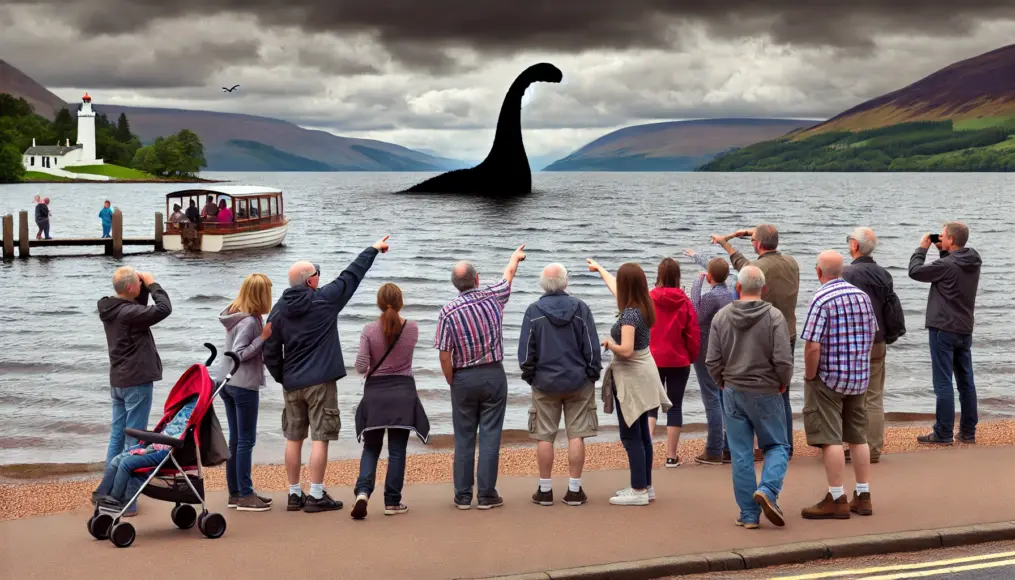The Loch Ness Monster, known worldwide as one of the most famous unidentified creatures (UMA), is believed to inhabit Scotland’s Loch Ness.
Over the years, numerous sightings and photographs have been reported, yet the true identity of Nessie remains a mystery.
In this article, we explore the origins, history, reported sightings, and scientific investigations surrounding Nessie, delving into the legend of this elusive creature.
Origins of the Loch Ness Legend and Historical Background

The first records of the Loch Ness Monster date back to around the 6th century.
At that time, stories of a monster harming people were documented, leading people to fear Nessie as a “beast.”
- Ancient Records
Around the 6th century, Saint Columba of Ireland is said to have encountered the monster at Loch Ness, marking one of the earliest written sightings.
Since then, reports of a strange creature in Loch Ness have persisted. - The Unique Geography of Loch Ness
Loch Ness is incredibly deep, with cold water constantly circulating through it.
Some believe that this geography makes it an ideal hiding place for Nessie.
Nessie Sightings and Their Credibility

Reports of sightings of Nessie surged in the 1930s, beginning with the famous “Surgeon’s Photograph.”
This photograph, showing a mysterious creature’s head and neck emerging from the lake’s surface, drew worldwide attention.
- The 1934 Surgeon’s Photograph
Taken by a British doctor, this image caused a sensation as potential proof of Nessie’s existence.
However, years later, it was revealed to be a hoax. - Continued Sightings
While the credibility of the photo has been questioned, sightings of Nessie have continued.
Numerous testimonies have been reported, with many tourists visiting Loch Ness hoping for a glimpse of the creature.
Scientific Investigations and Nessie as a UMA

Over the years, various scientific investigations have been conducted to determine Nessie’s existence.
Using technologies like sonar exploration and DNA analysis, scientists have searched the lake, often finding no evidence of a mysterious creature.
- Sonar Exploration
Since the 1970s, sonar scans of Loch Ness have revealed the presence of large, unidentified objects.
Despite this, Nessie’s identity remains unresolved. - DNA Analysis Results
Recent DNA analysis has examined biological traces in Loch Ness, but no evidence of Nessie was found.
Some scientists suggest that Nessie may not be a real creature but rather a misidentification or a legend.
Why People Are Still Drawn to the Mystery of Nessie

Interest in Nessie shows no sign of fading, as Loch Ness continues to attract tourists each year.
As a prominent unidentified creature (UMA), Nessie serves as a symbol of mystery, sparking curiosity and wonder.
- A Symbol of Mystery and Romance
Nessie represents the fascination with the unknown, embodying the human desire to explore mysteries that science cannot fully explain.
Visiting Loch Ness, many people find themselves wanting to believe in the monster’s existence. - An Important Tourist Attraction
For Scotland, Nessie is a valuable tourist attraction that supports the local economy.
The legendary creature draws people worldwide, adding to Loch Ness’s mystique.
Summary
- The Loch Ness Monster is famous worldwide as an unidentified creature (UMA) reportedly residing in Loch Ness, Scotland
- Since the 1934 “Surgeon’s Photograph,” numerous sightings have been reported
- Scientific investigations have yet to confirm Nessie’s existence, but the legend endures as a symbol of curiosity and mystery
The Loch Ness Monster transcends the label of a simple UMA, representing dreams and the allure of the unknown.
If you have the chance to visit Loch Ness, why not see if you can uncover the mystery of Nessie for yourself?
In this mysterious lake, everyone hopes for an encounter with Nessie.




Comment